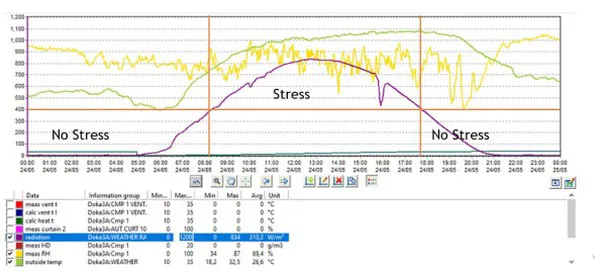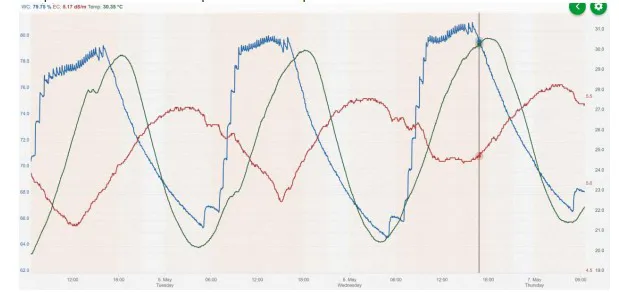In the first article in a mini-series on irrigation in semi-closed glasshouses Godfrey Dol discussed the right tools required to measure irrigation. In this second part he takes a look at the most important rules in irrigation.
1) A healthy, mature tomato plant uses approximately 1.7 ml/Joule/M2.
Light determines about 80-90% of the water uptake. Therefore, triggering irrigation based on light sum deserves preference. The Humidity Deficit of the glasshouse air determines the remaining 10-20% of the water uptake. Many growers open the vents in the spring so that plants get used to low humidity. It is a fallacy because a plant that can handle a high light intensity does not need to take up much more water to deal with low humidity. A healthy root system is the most important.
2) The drain percentage emerges from the desire to maintain a certain EC
I often get the question: how much drain should be achieved. It is an irrelevant question. The desired drain EC is the key parameter; the percentage drain is how the EC is controlled. If the desired drain EC is 4.5 and it reaches 5.0, the best way to lower the EC is through irrigating more. The best time to irrigate more is the middle of the day. If the EC in the drain is too high, increase the frequency of the irrigation between 11 am and 2 pm. If the drain EC is too low, decrease the frequency of the irrigation between 11 am and 2 pm. Some growers use light intensity to decrease the Drip EC during the middle of the day. I'm not a great fan of this, as I don't think it helps the plants transpire more easily, and it creates imbalances in the nutrient concentrations, especially when recirculating.
The following guidelines can be used to generate a drain that maintains a steady EC, based on a drip EC of 3.0 and a drain target EC of 4.5.
- less than 500 Joules; 0-10% drain
- 500-1000 Joules; 10-20% drain
- 1000-1500 Joules; 20-30% drain
- more than 1500 Joules; 30-40% drain
The important message here is that the drain percentage itself is not what should be targeted. The EC in the drain is the best indication of whether the plant gets enough water. The values in the table above change considerably if the grower targets a higher drain EC.
Decreasing the EC by irrigating more on a dark day is not a good strategy. On a dark day, we must reduce the amount of water significantly. The trigger for irrigation should still be light. It keeps the growing media from becoming too wet, and the roots are encouraged to 'find' water elsewhere.
3) The desired dry-down determines the timing of the last irrigation
Generally, a dry-down of 10-15% is recommended. A 10% dry-down (and less) is a vegetative action, whereas a 15% dry-down (or more) is a generative action. If the desired dry down is 10% and the sensors show 9%, the timing of the last irrigation needs to be earlier and vice versa. I prefer to be careful with the last irrigation. If the weather becomes cloudy during the late afternoon, the desired dry-down cannot be achieved. As it is impossible to take one irrigation away, it is better to be careful, and if it the dry-down is looking like it becomes too large, night irrigations are always an option. Maintaining a minimum dry-down of 10% ensures that the plants get enough oxygen into the growing media overnight.
On dark days where the light sum is only a couple of hundred Joules, there is no need to achieve drain. If we consider a day of 300 Joules, then the amount of water the plant uses is 300 Joules x 1.7ml/Joule/M2 = 510 ml/M2. Most standard slabs contain 10-15 liters of water, so there is no danger of the plant running out of water. If we irrigate twice at 0.25 liters/M2, the slab is saturated. It means that we have driven most of the oxygen out of the slab, which creates an ideal environment for soil diseases. One or no irrigation is a better option. It also means that during dark days, the saturation point on the moisture content meter is never achieved. As a result, the difference between the maximum and minimum moisture content is less. On these days, the dry down should be measured as the difference between the minimum moisture content of that day and the maximum saturation point of previous days.
Roots are like muscles; if you don't use them, you lose them. Three days of less than 500 Joules per day results in dying off of the root system. It is important to keep the above calculation in mind. Saturating the growing medium on these dark days results in Pythium and root dieback. In the graph below, you can see the irrigation strategy of a sunny day followed by a cloudy day. In this case, a scale was used. The maximum weight was 36.6 Kg (dark blue line). The minimum weight the next morning was 33.0 kg. The dry-down was (36.6-33.0)/36.6 = 9.8%. The next days' light sum was 432 Joules. The maximum weight increased to 35.4 Kg, so the saturation point was not achieved. No drain was achieved, which allowed for oxygen to remain in the root zone. The last irrigation was at 3 pm, and the weight decreased to 33.14 Kg by the next morning. It means that the timing of the last irrigation was perfect. It is a good way to manage the irrigation on a cloudy day. Also, note that the EC (light blue line) is rising. It means that during the next sunny day, the irrigation frequency has to be increased during the middle of the day to decrease the EC.
The blue line in the graph in Figure 2 represents the weight, and the peaks represent the weight of the irrigation water added to the growing media. We can turn the graph upside down, and we create a graph where the peaks mean the introduction of oxygen to the root zone. As the plants suck water out of the growing medium, it is replaced with air containing lots of oxygen. Overwatering would be less prevalent if we look at the graph that way.
 Figure 2; Bright and Dark Days Figure 3 shows the graph in mirror image, which gives a clearer perspective of the oxygen content of the growing media. To enlarge image, click here.
Figure 2; Bright and Dark Days Figure 3 shows the graph in mirror image, which gives a clearer perspective of the oxygen content of the growing media. To enlarge image, click here.
 Figure 3, Oxygenation of the growing media. To enlarge image, click here.
Figure 3, Oxygenation of the growing media. To enlarge image, click here.
4) The first drain should be achieved at 500 watts or 1.2-1.8 ltr/M2
During periods of high transpiration, we want to make it easy for the plant to take up water. The growing media should be saturated, and the EC becomes lower as the drain increases. Therefore, it is important to have the first drain at 500 watts. This rule of thumb can be applied regardless of where in the world you are. The second rule that can be applied is that the first drain should be achieved at 1.2-1.8 ltr/M2. This value depends on the desired dry down. If a dry down of 10% is required, the drain should come at 1.25 liters per square meter. At a dry down of 15%, the first drain should come at 1.8 liters per square meter. If the drain starts before that, the frequency in the morning is too fast.
During low or no radiation, we want to make it more difficult for the plant to take up water, so the roots are encouraged to spread through the growing media, looking for moisture. It is why we want to achieve a minimum dry down. In general, the plant sends assimilates to the warmest part of the plant. During the late afternoon, the growing media often is the warmest part (see also figure 4). Having enough air in the growing medium at a time when the assimilates are directed to the roots results in optimum root growth.
 Figure 4; The stress times of the plant. To enlarge image, click here.
Figure 4; The stress times of the plant. To enlarge image, click here.
Figure 4 shows that when concerning sunlight, there is stress on the plant and when not. During stressful times we need to make it easy for the plant to take up water. During less stressful times, we need to make it hard for the plant to take up water to encourage root growth.
The above strategies help implement the four key parameters for irrigation; a start time, first drain time, the total amount of irrigation water, and stop time. By following these rules of thumb, the grower creates an environment for the roots where they are kept healthy and aerated so that they can perform at maximum transpiration when required.
 Figure 5; Moisture content, EC, and temperature measurement of the root zone. To enlarge image, click here.
Figure 5; Moisture content, EC, and temperature measurement of the root zone. To enlarge image, click here.
Figure 5 shows a typical rootzone temperature, moisture content, and EC graph. In the morning, the moisture content is quickly brought up to the saturation level, and the drain starts at the 8th irrigation (cycle size 0.2 ltr/m2). The EC decreases quickly during the day and starts rising again after the last irrigation. At the same time, the moisture level decreases, meaning air is entering the root zone. Moisture measurement within the slab has greatly enhanced the understanding of the irrigation requirements of plants.
While manufacturers of moisture meters claim that their meters are compensated for temperature, the reality is often different. In the graph above, it appears that over three days, the moisture content is increasing. That is not true. The increase in water content is caused by an increase in temperature and EC over the three days of measurement. It complicates the interpretation of the data. However, the most important information from the moisture content meter is the difference between minimum and maximum. This difference is less prone to fluctuations.
If no moisture content measurement is available, we can still get the dry-down information from manual drain stations. By physically checking the manual drain stations for the first drain every day, we can backward calculate the dry-down. For instance, if we know at which irrigation cycle the first drain arrived, we know the volume of water added to the slab at that time.
If we know the saturation weight of the slab, we can calculate the dry down that was achieved. For instance, if the drain arrived at the 5th cycle and we give 100 ml per cycle, there are four drippers per slab, and the slab saturation volume is 15 Liters, we can calculate that it took 5 x 4 x 100 = 2,000 milliliters to re-saturate the growing medium. We should allow for the water uptake for the plant during that time as well. If the first drain came after 200 Joules, then we can calculate the water uptake from the plant as 200 x 1.7 ml/Joule/M2 = 340 ml/M2. If the dripper density is 2,5 plants/M2, the four plants on one slab have taken up 340 x 4/2.5 = 544 ml per slab. The real dry down is (2,000- 544)/15000 = 9.7%.
It seems like a lengthy calculation, but the only variables are the number of irrigations before the first drain, and how many joules have accumulated at the first drain. If the grower in the above example wants to maintain a 10% dry-down, he only has to make sure that the first drain comes at the 5th irrigation at 200 joules light sum. If he wants to increase dry down to 15%, the first drain must arrive at the 7th irrigation at 200 joules.
This mini-series of three parts about irrigation-strategy in semi-closed glasshouses will continue with discussing how to manage the irrigation and what strategies to use for different stages of the crop.
While the irrigation strategy in a semi-closed glasshouse doesn’t differ from a conventional glasshouse, Godfrey hopes that this series clarifies in relative simple terms what is important in determining the right irrigation strategy. The strategy described in this series was the strategy used by the Automatoes Team, who won the Autonomous Glasshouse Challenge this year with the lowest water and fertiliser use.
For more information:
Glasshouse Consultancy
www.glasshouse-consultancy.com
Godfrey Dol
LinkedIn
[email protected]
+81 80 700 94 006
